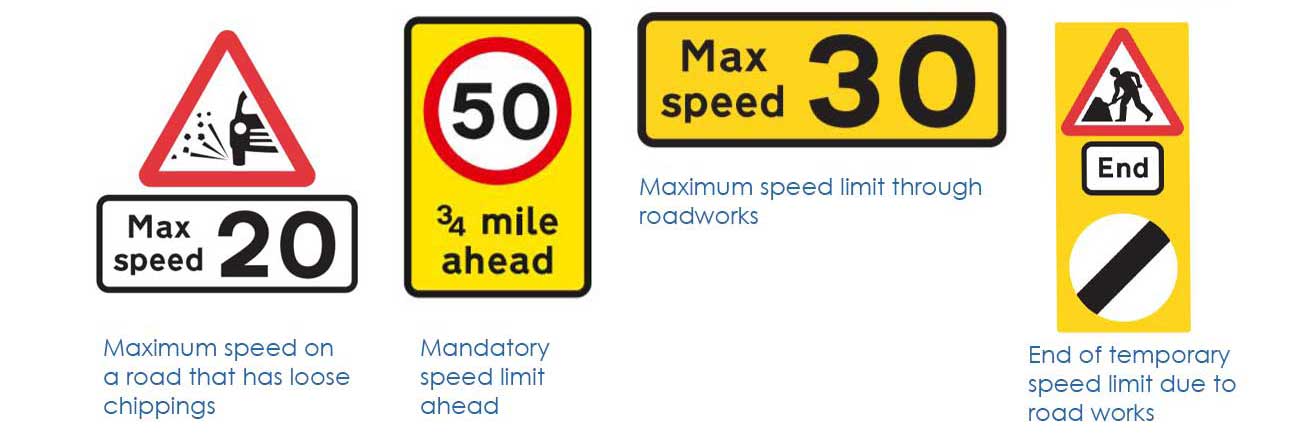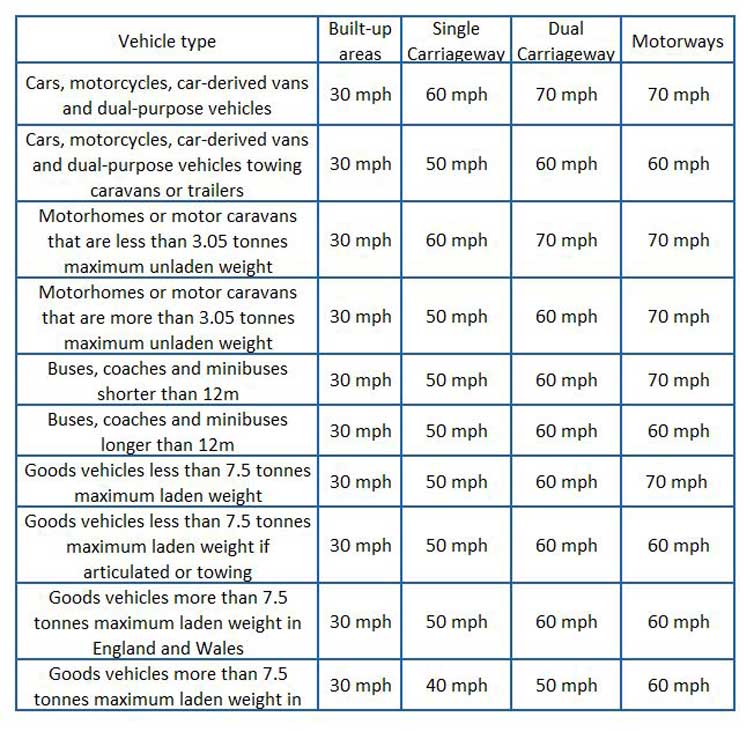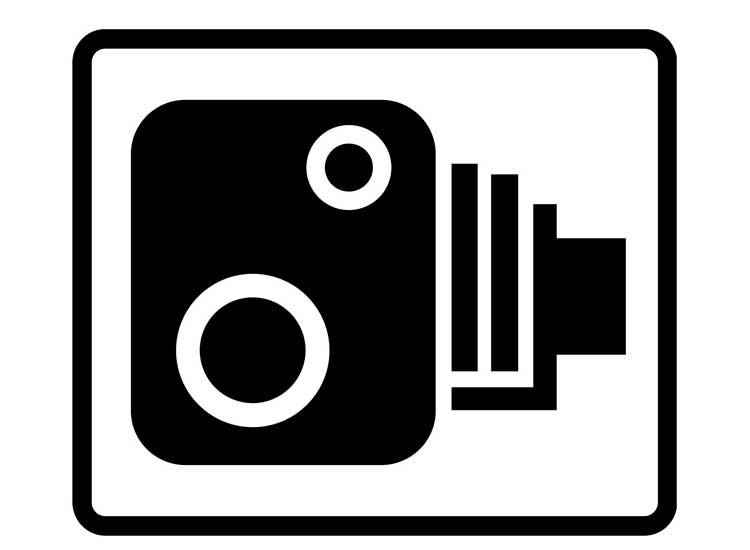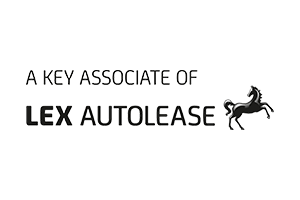There are a number of different speed limits in the UK from 20 miles an hour up (mph) to 70 mph on public roads.
All speed limits shown in the UK are in miles per hour.
The usual speed limit sign you will see is a white circle surrounded by a red circle with the miles per hour limit in black within the circle.
The other limit sign you commonly see is the one for the national speed limit which is a white circle with a black diagonal line through it. The national limit is 60 mph on a single carriageway and 70 mph on dual carriageways.

Image ssourced: https://assets.publishing.service.gov.uk/media/58170307ed915d61c5000000/the-highway-code-traffic-signs.pdf
There are other signs for speed limits you might see as well which we have included in the above picture.
The first two on the left of the image show a speed limit and national speed limit, which we’ve already mentioned.
If a speed is shown in a blue circled, like the middle images, this is a minimum speed. When this has a red line through it this means it is the end of the minimum speed limit. Minimum speed limits are usually used on tunnels where slow moving vehicles can cause a hazard for traffic and cause more pollution on a stretch of road with reduced air flow.
Speed limits can also be set locally, for example you will see a lot of places apply a 20 mph limit near schools or a 50 mph limit on one that would usually be a national speed limit of 60 mph if there are a lot of junctions or sharp bends. The far-right signs show what speed limit signs entering a local speed limit zone, which are the type you will usually see in school zones.

Image sourced: https://assets.publishing.service.gov.uk/media/58170307ed915d61c5000000/the-highway-code-traffic-signs.pdf
Some of these may also be temporary signs like the ones above. On the far left is the sign for a speed limit in an area with loose chippings on the road. This is usually used following road works or repairs and will usually only be needed for a few months until the road surface settles.
The three yellow signs are used in areas where road works are being completed. The left one is often seen as you approach the roadworks to let you know a temporary lower speed limit will apply shortly. The middle is used when the speed limit comes into force. The right one shows the end of roadworks and speed limit. The bottom of this sign also shows the speed limit beyond the roadworks however this is not always included.
With the rise of smart motorways we’ve also seen an increase in roads with variable speed limits. This will be noted on signs before you enter such a road and the limit will then be shown across the lanes on electronic screens above the road.
There are some vehicles that might have a lower speed limit than the one signposted on the road. We’ve rounded up the national speed limits for vehicles in the chart on the right.
As you can see there are a number of vehicles that are limited to lower speeds and you should not pressure them to exceed these limits when driving if you are in a vehicle with a higher speed limit.
You might also find that some drivers are not as comfortable with reaching the speed limit as you. These are typically; learner or newly passed drivers, older drivers or drivers who do not know the roads or area they are driving in. You cannot always tell who a driver is, unless it’s a learner with L plates or in a driving school car, and so you should never pressure another vehicle to drive faster. When it is safe to legally do so you can overtake them if needed.
It’s important to remember that speed limits are the maximum speed you can drive and it might not always be safe to drive at the speed limit, for example when the weather is bad or around cyclists.
In the UK speed cameras are used as a way of reducing the number of speeding motorists and creating safer roads.
These cameras use detectors in the road or radar technology to record the speed of a vehicle. The camera will also record the time and date of the offence and the speed limit on the road.

When the camera detects speeding it takes a photograph, which will show the vehicle type and registration number and sometimes the driver.
There are a wide variety of speed cameras that are currently in use in the UK that are split into four categories; fixed speed cameras, average speed cameras, speed and traffic cameras and mobile speed cameras. We’ve rounded up some of the most common ones below.
Fixed Speed Cameras:
- Truvelo Combi Forward Facing – this stationary camera can be forward-facing or rearward-facing.
- Gatsometer Type 24 – this is a fixed rearward-facing camera.
- Speedcurb Camera – this rearward-facing camera is often mounted in pairs to monitor four lanes of traffic at once.
Average Speed Cameras:
- Vector – this is officially known as a two-lane bi-directional camera that uses automatic number plate recognition (ANPR).
- Digital Specs – these also use ANPR to police average speed zones and is most commonly seen on motorways.
- HADECS – Highways Agency Digital Enforcement Camera System also known as HADECS are usually used on smart motorways to enforce variable speed limits.
- Siemens SafeZone – these cameras only came to the UK in the last couple of years, they can capture speeds between 20 and 140 mph.
- SpeedSpike – these also use ANPR to check the average speed motorists are driving through the area they cover.
- REDFLEX Speed Cameras – these cameras can be used on motorways to catch speeding across six lanes of traffic.

Speed and Traffic Cameras:
- Truvelo D-cam – these cameras look at
- - A speed and red light camera in one that can cover up to three lanes of traffic and be rear
There are also a number of cameras that focus on other traffic violations like going through a red light.
Mobile Speed Cameras:
- Mobile speed cameras – operated by police officers in vans at the side of the road there are a variety of cameras that use radar and laser technology.
- DS2/SpeedMaster/Autovision/Autovision 2 – These are semi-permanent installations that can cover two lanes at once.
- Long Ranger camera – This camera is also held by police officers and radar can capture speeding from a distance of 1000m.
The Cost of Speeding:
Speeding not only increases the risk of crashing but also the severity of injuries if you are involved in a crash.
We touch on this in our opening Road Safety Week post with our look at Nilsson’s Power Model which shows a 5% increase in average speed leads to approximately a 10% increase in all injury accidents and a 20% increase in fatal accidents.
A report by the World Health Organisation (WHO) suggests that an increase in average speed of 1 km per hour results in 3% higher risk of a crash involving an injury and a 4-5% increase for crashes that result in a fatality. 1 km per hour is equivalent to just 0.6 of a mile.
The impact that the speed of a car involved in an accident has is even higher for vulnerable road users like pedestrians and cyclists.
The National Travel Survey for England in 2019 found that 54% of cars exceeded the speed limit on motorways with a speed limit of 30mph, 50% exceeded it on motorways and 9% on single carriageways with a national speed limit in place.
This report is not reflective of speeds across the entire road as it was a sample from the Department for Transport’s automatic traffic counters that were chosen to exclude external factors that might restrict driver behaviour.
The report also stated that overall vehicle compliance with speed limits has remained broadly stable since 2011, and this year the average car speeds under free flow conditions were close to the speed limit on motorways at 69mph, and 30mph roads at 31mph. and under the speed limit on 60mph roads at 50mph. Suggesting that on average drivers are keeping close to the speed limits.
On a personal level if you are caught speeding then there are three places it can hit you:
- Fines – You can be issued with a fine of up to £2,500 depending on whether you take the case to court.
- Points – If you are caught speeding then you can receive upwards of three penalty points on your driving licence.
- Time – Alternatively you may be given the opportunity to attend a speed awareness course instead, provided you have not been on a speed awareness course in the previous three years and it is considered appropriate by the police.

Why You Shouldn’t Speed:
As well as the ones we mentioned above there are a lot of other reasons you shouldn’t speed. These include:
- Save fuel – going slower can save you fuel if you’re on roads with higher speed limits as there is less drag, which makes your engine work harder and burn more fuel.
- Little impact on time – Even if you are doing several miles over the limit and do not have to slow down or stop for traffic signals, you’re unlikely to get to your destination significantly earlier.
- Reduce wear and tear – speeding can decrease the time it takes for general wear and tear to occur. Your tyres in particular can wear down much quicker if you are regularly speeding.
- More time to react – going slower gives you a better awareness of your surrounds and more time to react to any potential hazards.
- Less stressful – speeding can be stressful, you put yourself under extra pressure to recognise and react to hazards in less time and you’re more likely to be annoyed with other road users as even those doing the speed limit will feel slow to you.
How to Slow Your Speed:
A speed limiter legally has to be fitted to some vehicles, including those with more than eight passenger seats and goods vehicles with a maximum laden weight of more than 3.5 tonnes. This is to prevent them from going over their maximum allowed speed and they reduce the maximum speed by restricting the fuel supply to the engine. You can also fit a speed limiter to a car if you are concerned about your speeding.
Some insurance companies don’t fit a speed limiter but do use a black box for young drivers. This monitors their speed as well as braking and acceleration usually. This not only helps drivers track their driving patterns but also stick to speed limits.
One obvious way you can slow your speed is by choosing an alternative method of transport. Cyclists and pedestrians travel a lot slower than cars, and not only is this good for your speed but they’re also better for the environment and your health.
We know that this isn’t always an option though and there are a number of methods you might find useful to help you reduce your speed. Below are our top 10 tips:
- Know the cost of speeding – we mentioned earlier that you could be fined and have points added to your licence. Remind yourself of this, and consider whether you can actually afford these penalties before speeding up.
- Plan your route – if you plan your journey before you set off this will help you work out how long the drive should take so you can leave an appropriate time.
- Leave earlier – if you leave a little earlier you will give yourself a little buffer time in case you hit traffic.
- Ignore others – if someone is driving aggressively behind you to try and pressure you into speeding up then ignore them.
- Know your speed limits – whether it’s getting to know the limits on your most driven routes by heart or utilising a sat-nav or map system that shows you the limit whilst moving you should always know the limit on the road you’re driving on.
- Pay attention to your speedo – make sure you keep an eye on what speed you are travelling at, we suggest doing a little under the limit so that you’re less likely to accidently go over it.
- Drive a manual – when accelerating in a manual car you physically have to change the gear several times, this again will usually get you to monitor your speedo and be more aware of how fast you are driving.
- Utilise cruise control – if you’re on a motorway or road with a national speed limit then you should use cruise control as this will prevent you from accidently speeding.
- Burn your need to speed in other ways – go-karting, racing days at the track or even video games allow you to speed without endangering yourself or others.
- Listen to something relaxing – whether its slow music, a podcast or talk radio listen to something that helps keep you calm.
Let us know in the comments below if you have a helpful way for other drivers to slow their speed!









Leave a Comment